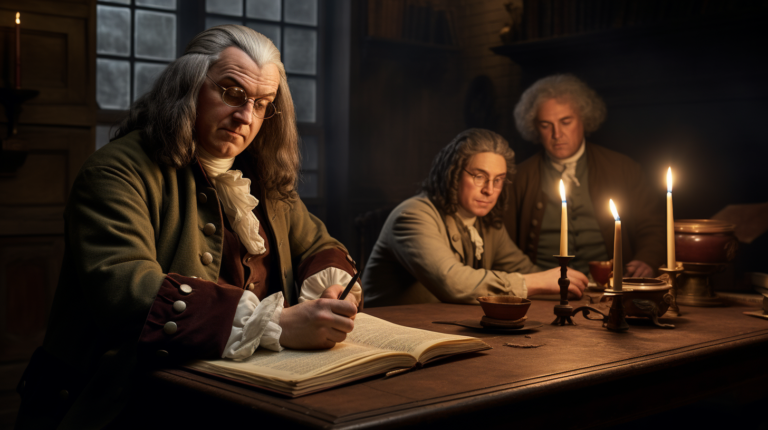Ben’s letter back to Priestley described his decision method, and it is widely accepted as the first written account of a “decision-assistance” technique. You can enjoy reading it below.
When you do, you’ll see him describe some challenges with which we are all familiar, today – challenges that the decision-assistance technology that powers the ProRRT℠ was designed to help solve. One of the most important of these, as Ben points out, is that “there is often too much information to consider . . . and that makes decisions difficult.” Without the benefit of modern technology, Ben classified “factors” and “weighted” them, and then comparatively evaluated them to help in making his decision. Sound familiar?
However, Ben mentions that his decision-making process involves three to four days while, with the ProRRT℠ the process can take you mere moments . . . a key benefit of our patented decision-assistance technology.
So, did Ben Franklin anticipate the ProRRT℠? In a way, we believe he did. He certainly recognized the problem of having too much information, applied logic to find a way to productively use the information, and articulated a benefit of the use his process (a benefit shared by ProRRT℠ users) – that by doing so one is “less likely to take a rash step.”
Unfortunately for Ben, he was way ahead of his time and didn’t the benefit of ProRRT℠ technology. You do or, at least, you can. We wonder what he would have thought to see the speed and effectiveness of scoring and ranking hundreds of mutual funds and ETFs (and doing multiple “what if” tests, by adjusting factors and weightings) in mere moments. Perhaps he would have been an “early adopter” and might have been able to write a shorter letter.
THE BEN FRANKLIN LETTER
The letter below is a response from Ben Franklin to Joseph Priestley’s letter requesting assistance on making a difficult decision. Ben’s letter back to Priestley described his decision method, and it is widely accepted as the first written account of a “decision-assistance” technique. Although, the technology and techniques have advanced in the last 250+ years, the rationales behind using a decision-assistance process still remain.
Letter To Joseph Priestley London, September 19, 1772
Dear Sir,
In the Affair of so much Importance to you, wherein you ask my Advice, I cannot for want of sufficient Premises, advise you what to determine, but if you please I will tell you how.
When these difficult Cases occur, they are difficult chiefly because while we have them under Consideration all the Reasons pro and con are not present to the Mind at the same time; but sometimes one Set present themselves, and at other times another, the first being out of Sight. Hence the various Purposes or Inclinations that alternately prevail, and the Uncertainty that perplexes us.
The point is made that there is often too much information to consider at a single point time and that makes decisions difficult. Consider, in comparison, the much greater amount of information available today, in this “Information Age.”
To get over this, my Way is, to divide half a Sheet of Paper by a Line into two Columns, writing over the one Pro, and over the other Con. Then during three or four Days Consideration I put down under the different Heads short Hints of the different Motives that at different Times occur to me for or against the Measure.
Ben is collecting all the factors he needs to consider within his decision process, and he is classifying his factors into Pros & Cons. The method he employs aligns closely with what we do today with our division of mutual fund and ETF performance factors between “Return” maximization-related and “Risk” minimization-related factors.
When I have thus got them all together in one View, I endeavour to estimate their respective Weights; and where I find two, one on each side, that seem equal, I strike them both out: If I find a Reason pro equal to some two Reasons con, I strike out the three. If I judge some two Reasons con equal to some three Reasons pro, I strike out the five; and thus proceeding I find at length where the Ballance lies; and if after a Day or two of farther Consideration nothing new that is of Importance occurs on either side, I come to a Determination accordingly. (emphasis added)
Once he has his factors classified, he weights them. He is not actually applying any math, but he’s using process of elimination to strike the factors from the decision, by identifying their relative weightings.
And tho’ the Weight of Reasons cannot be taken with the Precision of Algebraic Quantities, yet when each is thus considered separately and comparatively, and the whole lies before me, I think I can judge better, and am less likely to take a rash Step; and in fact I have found great Advantage from this kind of Equation, in what may be called Moral or Prudential Algebra. (emphasis added)
One final and most important point here is that he’s applying a process to remove ‘rash’ emotions from his decision.
Wishing sincerely that you may determine for the best, I am ever, my dear Friend,
Yours most affectionately,
B. Franklin
Ben didn’t have the benefit of our patented, decision-assistance technology – YOU DO!
Source: Mr. Franklin: A Selection from His Personal Letters. Contributors: Whitfield J. Bell Jr., editor, Franklin, author, Leonard W. Labaree, editor. Publisher: Yale University Press: New Haven, CT 1956.


